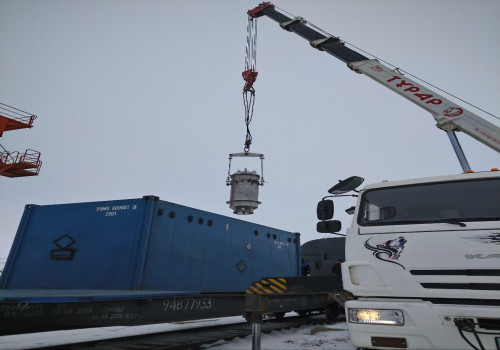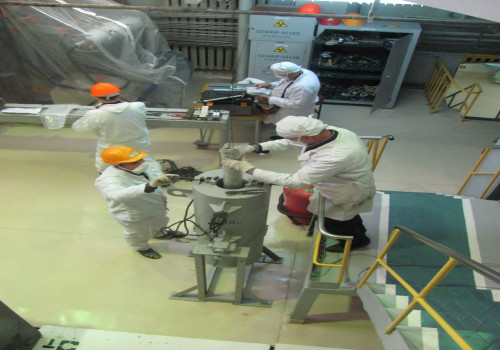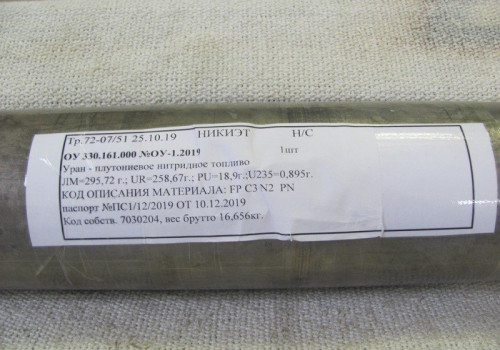TESTING OF A PROMISING MIXED NITRIDE URANIUM-PLUTONIUM FUEL OF THE RUSSIAN LEAD-COOLED FAST REACTOR (BREST-OD-300)
01 June 2022



30 Projects to the 30th Anniversary of NNC RK!
Project No.28 Period of 2019–2022. TESTING OF A PROMISING MIXED NITRIDE URANIUM-PLUTONIUM FUEL OF THE RUSSIAN LEAD-COOLED FAST REACTOR (BREST-OD-300)
BREST is ongoing project under development in Russia for a line of fast-neutron reactors with lead coolant, a two-circuit heat removal to the turbine, and overcritical steam parameters.
At the moment, the developers are focusing their efforts on BREST-OD-300 ("pilot demonstration") reactor facility on which a large number of new design solutions are to be tested. The selected power of 300 MW (el.) and 700 MW (thermal) is the minimum required to obtain a fuel reproduction factor in the core equal to one.
Rosatom representatives consider BREST as an integral part of "Breakthrough" project, which consolidates projects to develop fast-reactors of high power, closed nuclear fuel cycle technologies, and new types of fuel and materials aimed at achieving a new quality of nuclear power.
The features of BREST reactor include the design of fuel pins. As fuel, a mononitride composition of uranium-plutonium (MNUP-fuel) and minor actinoids (isotopes of neptunium (Np-237), americium (Am-241, Am-243) and curium (Cm-242, Cm-244, Cm-245) is used.
Despite the positive results of analytical evaluations performed to prove the reliability and safety of fast reactors with mononitride fuel, the project developers are implementing experimental verification of the declared parameters of fuel operability, including justification of the reliability and operability of MNUP-fuel in transient and emergency modes of reactor operation.
In 2016, specialists of NIKIET JSC (the developer of BREST project, Moscow) chose the IGR reactor for extreme fuel tests as the most suitable for this purpose, especially taking into account the unique experience of RSC NNC RK staff in similar studies in the past and the present.
As a result, under two commercial contracts with NIKIET JSC, RSE NNC RK performed a feasibility study of the experiments, including justifying calculations of safety using NIKIET JSC's chosen irradiation device (IRD) and design and experiment execution scheme. At the same time, NNC specialists ensured the development of necessary set of calculation tools, which were used in the process of not only selection and validation of reactor operation modes during tests, but also for computational analysis of their results.
Five irradiation devices were supplied for testing, each of which contained three model fuel pins containing MNUP fuel manufactured by VNIINM JSC (fuel pins were installed in the irradiation device in NIIAR JSC, Russian Federation).
The basis of MNUP fuel composition composed of depleted uranium (uranium-235 content - 0.2%) and plutonium with the following isotopic composition: Pu-238/Pu-239/Pu-240/Pu241/Pu-242= 0.03/95.58/4.25/0.12/0.02%.
Among the three fuel rods installed in each ID, two of them were equipped with means for measuring parameters (fuel cladding temperature, fuel temperature, pressure in the compensation volume of the fuel pin). One of the fuel pins - the so-called normal one - had no means of measuring parameters to exclude the influence of sensors on the performance of the fuel pin.
In addition to the fuel pin parameters, each ID was measured:
- the temperature of ampoule casing in which the fuel pins are installed;
– lead temperature (coolant);
–ampoule pressure;
–neutron flux in the ampoule
The target test parameter was the threshold values of the average radial enthalpy of the fuel, at which irreversible changes in the fuel rod structure occur (fuel fragmentation, depressurization of the fuel pin cladding by various mechanisms of its destruction, up to its melting).
MNUP fuel tests included methodical and research start-ups, which were conducted in "flash" and "pulse" modes.
Based on the results of methodical start-ups (three experiments), the calculation models and calculation results were verified and the parameters of the IGR reactor systems adjustment during test start-ups were specified. In addition, the parameter measurement tools were checked, the gamma radiation control detectors and small-scale neutron flux detectors were calibrated.
The exploratory start-ups were planned and performed so as to realize energy release in the fuel in a wide range of values - from the nominal operational level of energy release at constant power to the energy release limits under conditions of simulated power bursts, which are typical for reactivity accidents. At the same time, the upper limit of the range of realized loads on MNUP-fuel guaranteed to overlap the region of safe values of fuel enthalpy within which there is no damage to fuel pins.
The tests of MNUP-fuel performed at the IGR reactor gave the developers of BREST-OD-300 reactor unique information that will be used to expand the evidence base for justifying the safety of reactor operation. At the same time, there is an obvious need to improve the statistical reliability of the experimental results where the opinion of RSE NNC RK and JSC "NIKIET" specialists absolutely coincide. In this regard, both research groups are unanimous in the opinion that the experiments on the IGR reactor should be continued, expanding their scope and focusing on the in-depth study of the main factors that can affect the thermal reliability of MNUP-fuel.
After the tests were completed, all irradiating devices were returned to the Russian Federation for post-reactor studies at JSC NIIAR (Dimitrovgrad city).
Latest news by category:
-
NNC RK Participated in CIS Commission Meeting on Peaceful Use of Atomic Energy
17 December 2025
-
Pivotal Role of Kazakhstan in Global Thermonuclear Fusion Research
17 December 2025
-
Enhancing Human Resources Development with Support of JAEA
09 December 2025
-
Collaborative Push for Fusion Power
09 December 2025